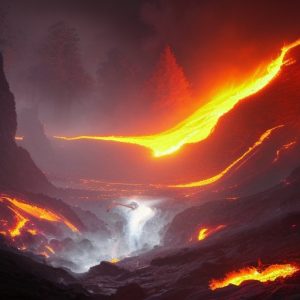
The future has arrived, people! With the eruption of spontaneous, randomly occurring lava blasts that devour buildings in flames, we’re forced to explore this volcanic phenomenon. In this article, we examine the science behind these lava eruptions and what we’re in for. How do we anticipate and respond to this kind of rage from Mother Nature? Can we harness its destructive power for good? We’re excited to present our findings and detail creative solutions that allow us to thrive in the face of danger. Get ready to laugh, to learn, and to survive-induced farce!
I. Introduction
In a world where the mundane meets the absurd, we find ourselves amidst a crisis that is both terrifying and hilarious. Imagine going about your day, going to work, walking the dog, and suddenly, a burst of lava appears out of nowhere, covering your entire neighborhood in crimson flames! It sounds like something out of a science fiction novel, but here we are, living in a reality where such events are not impossible.
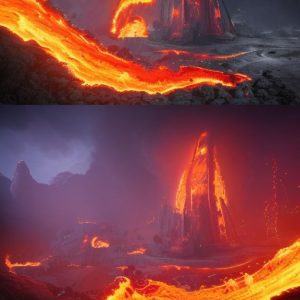
But enough with the doom and gloom, let’s talk about what we do best: laugh through our problems. As an 80s science fiction writer with a great sense of humor, I find it both surprising and delightful that such a perilous outburst is now the butt of our jokes. We’ll gladly join in the laughter, but let’s not forget that this is a serious matter.
In this article, we’ll explore the science behind these random lava appearances, the impact they have on communities, the technology that can help predict and respond to them, and dare we say it, the possibility of using them as a source of energy.
But, before we dive into the nitty-gritty of it all, let’s take a moment to imagine the absurdity of our situation. Imagine a world where walking the dog could lead to being swallowed up by a river of molten rock. Or, where commuting to work could require a boat and a shovel. It’s the stuff of science fiction, but we’re living it.
So, grab your popcorn, kick back, and let’s explore the ridiculousness and potential of the bizarre phenomenon of lava showers that seem to appear out of nowhere.
II. The Science of Lava Emergences
Picture a planet where the ground beneath your feet can turn into a lava flow seemingly out of nowhere. A world where volcanoes aren’t predictable, they’re spontaneous. This is what we’re dealing with when it comes to these random lava appearances. But how and why do they happen?
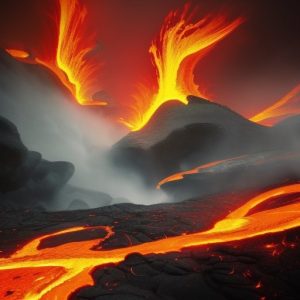
Firstly, let’s talk about volcanoes. A volcano is an opening in the Earth’s crust where magma, rock fragments, ash, and gas are released. However, not all volcanoes are created equal. Some volcanoes erupt explosively, while others release lava flow quietly. The type of volcano depends on the type of magma, the temperature, and the amount of gas contained in it.
Now, let’s focus on the reason behind these random appearances. While volcanoes are the most obvious sources of lava, they’re not the only ones. Lava can also come from underground magma chambers that reach the surface due to tectonic activity or other geological processes. In some cases, the Earth’s crust can even crack open, allowing lava to seep through.
The strange thing about these random lava appearances is that they seemingly spring up from nowhere, catching everyone off guard. But in reality, there are warning signs that scientists can use to predict such events. Changes in temperature and gas emissions, as well as unusual seismic activity, can all indicate that something is happening beneath the surface.
III. The Impact of Random Lava Appearances on Communities
As anyone who has lived through a lava shower knows, the impact on a community can be both immediate and long-lasting. The chaos and destruction of such a tragic event can be difficult to imagine, but it is important to understand just how devastating it can be.
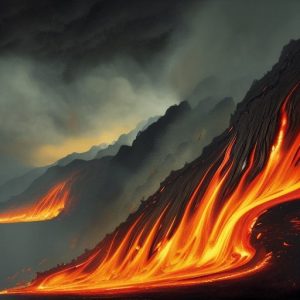
Firstly, there is the obvious physical destruction caused by the lava. Houses, buildings, and infrastructure are all at risk of being swallowed up by the hot and molten rock, leaving nothing but destruction in its wake. The effects of a sudden lava shower can linger for years, if not decades, as the community struggles to rebuild homes, businesses, and even whole neighborhoods.
But the damage is not just physical. The psychological impact of such a traumatic event cannot be ignored. The suddenness and unpredictability of the lava shower can leave people feeling fearful and anxious about the future. Families may be displaced from their homes, losing their sense of security and stability. It can be challenging to rebuild lives after such a traumatic experience, and the mental and emotional strain can be overwhelming.
However, for all the devastation that a lava shower can cause, it is important to remember that there may also be opportunities for growth and innovation. In the aftermath of a disaster, communities often come together to support one another and find new ways to rebuild and recover. Scientists and engineers may work to find new technologies to predict and combat the lava, paving the way for more advanced warning systems and protective measures.
IV. The Role of Technology in Predicting and Responding to Lava Outbreaks
As we marvel at the absurdity of lava appearing out of nowhere, the question we must ask ourselves is how can we predict and respond to such a chaotic event? For the answer, we turn to technology.
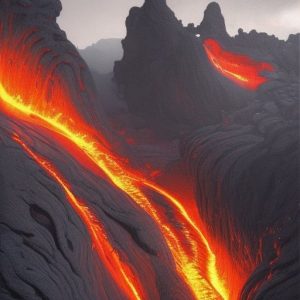
First and foremost, drones are our eyes in the sky, and for a good reason. They’re small, agile, and provide aerial footage that can help predict the path of the lava flow. What’s more, they can venture into areas that are too dangerous for humans to access to monitor and assess the impact of the lava outbreak.
Secondly, we have the Lava Simulator; it’s the perfect tool for testing different scenarios and predicting the path of the lava flow. It’s also an excellent tool for training emergency responders who will have to deal with the aftermath of a lava outbreak. They can use it to simulate various possible outcomes and come up with strategies on how to mitigate the damage done to communities.
Another critical piece of technology that we must not forget is Geographical Information Systems (GIS). GIS helps map the topography and geological features of an area that could be susceptible to a lava breakout. It’s an excellent tool for predicting the path of the lava flow and for developing strategies for evacuation routes, safe zones, and emergency shelters.
Let’s not forget the importance of communication technology. In the event of a lava outbreak, time is critical, and communication is key. We need a system that can quickly provide alerts, warnings, and updates on the situation. The Emergency Alert System (EAS) does precisely that, sending out messages to specific areas, warning them of an impending lava danger. We also have network radios and Wi-Fi mesh technology that can provide instant communication between emergency responders on the ground.
V. Unleashing The Fire
As we’ve seen, these lava showers might seem like a disaster, but perhaps they hold the key to a future power source. Rather than running from the flames, we could harness this earthy energy for our needs.

Imagine a world where we could use the heat from the lava to power our homes, drive our vehicles, and even fuel our spaceships. It may seem like a far-fetched concept, but with the right technology, it could very well become a reality.
One of the biggest advantages of lava power is its abundance. These eruptions happen all over the world, meaning that a steady supply of power could be generated if we can learn to harness it effectively. It’s a low-hanging fruit that could revolutionize our energy industry.
Moreover, using lava as a power source doesn’t generate greenhouse gases, which makes it an eco-friendly option. As we continue to grapple with climate change, this could be one of the answers to our energy woes.
But how could we possibly harness lava power, you may ask? Well, one idea could be to use heat exchangers to transfer the heat from the lava to a coolant, which could then be used to power turbines. It’s a simple yet effective technology that has been used in the geothermal energy industry for years.
Another possibility could be to use the pressure from these eruptions to drive turbines directly, similar to how hydroelectricity works. It’s an innovative and exciting technology that could again revolutionize our energy industry.
So, while these lava outbreaks may seem like a disaster, perhaps they hold more promise than we initially thought. With the right technology and understanding, we could be on the brink of a new energy era, one that harnesses the power of nature itself.
VI. Science Fiction Surpasses Reality
Who says science fiction can’t solve real-world problems? In fact, it might be the very genre that offers the most creative solutions to our present dilemma: random lava outbreaks.
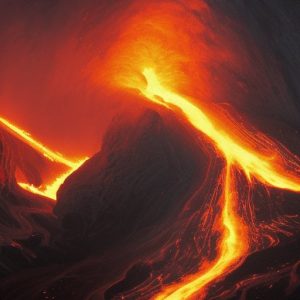
One such solution might involve harnessing the very energy generated by these fiery eruptions. Imagine a world where we could predict when and where lava was going to erupt, and we could use that energy to power entire cities! Sound like a fanciful dream? Perhaps, but it’s not as far-fetched as you might think.
Another solution is to deploy science fictional-inspired technology. Perhaps we could use drones that are equipped with heat-resistant materials to survey the lava flow and report back to emergency responders, who could then use the information to get people to safety. Or, maybe we could use specially designed robots that have been trained to navigate through lava-covered terrain, helping scientists get closer to the source of the lava eruption to study it more effectively.
And, if we really want to lean into the science fiction vibe, we could even consider creating a force field that can surround a building, blocking out the lava before it reaches it. It might sound like something out of Star Trek, but technology like this could very well become a reality in the not-too-distant future.
Of course, these are all just hypothetical solutions. But, it’s not outside the realm of possibility that they could be developed in the coming years. After all, science fiction has always been a source of inspiration for innovators and inventors. Who knows what kind of breakthroughs might arise from the challenge of dealing with spontaneous lava outbreaks?
The good news is that we can approach this problem with a sense of humor and an open mind, and who knows, maybe we’ll find solutions that surpass even our wildest expectations.
VII. Conclusion
As we come to the end of our journey through the bizarre and bewildering world of random lava appearances, it’s hard not to feel a sense of awe and amusement. The phenomenon may be daunting, but it has given rise to some unusual and comical ideas (like using lava as a source of energy!).

But amidst the laughter, let us not forget the real impact that these occurrences have on people’s lives. The destruction of homes and communities is no laughing matter, and we must take every possible step to protect ourselves from such disasters.
We must use science and technology to make predictions and better understand this fascinating and unpredictable world we live in. And perhaps, most importantly, we must have a sense of humor to help us through the chaos of life.
Whether it’s finding the humor in the midst of the ashes or coming up with creative solutions to the problems that arise, we must learn to laugh through our problems. Because in the end, laughter might just be the best medicine.
So let’s keep exploring the weird and wonderful world of science and fiction, with its unpredictable twists and turns. Who knows, maybe the next big idea or breakthrough will be found in the midst of some laughing fit? With science fiction, anything is possible. Keep exploring readers, keep laughing, and never stop dreaming.






